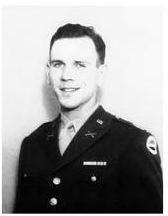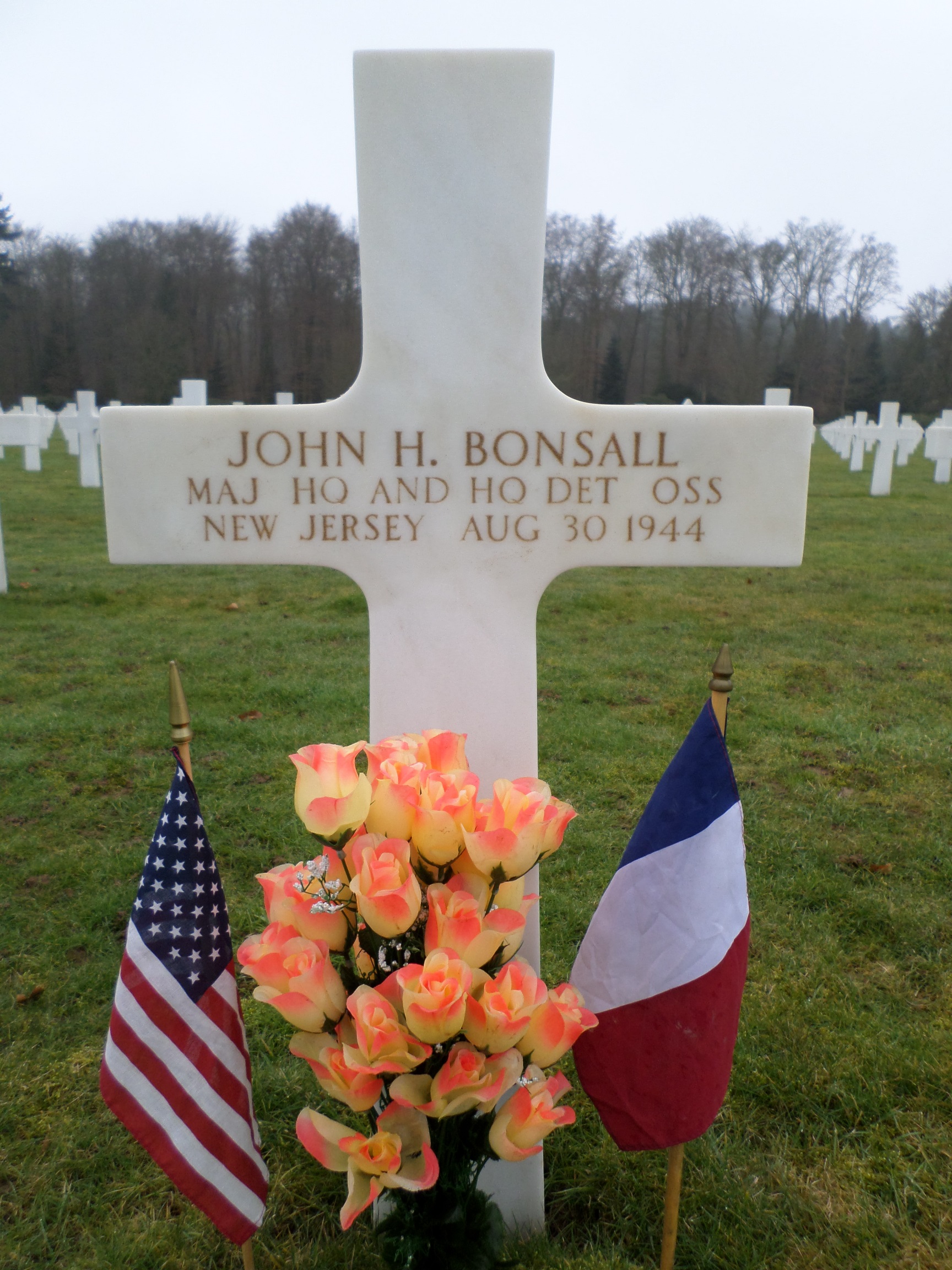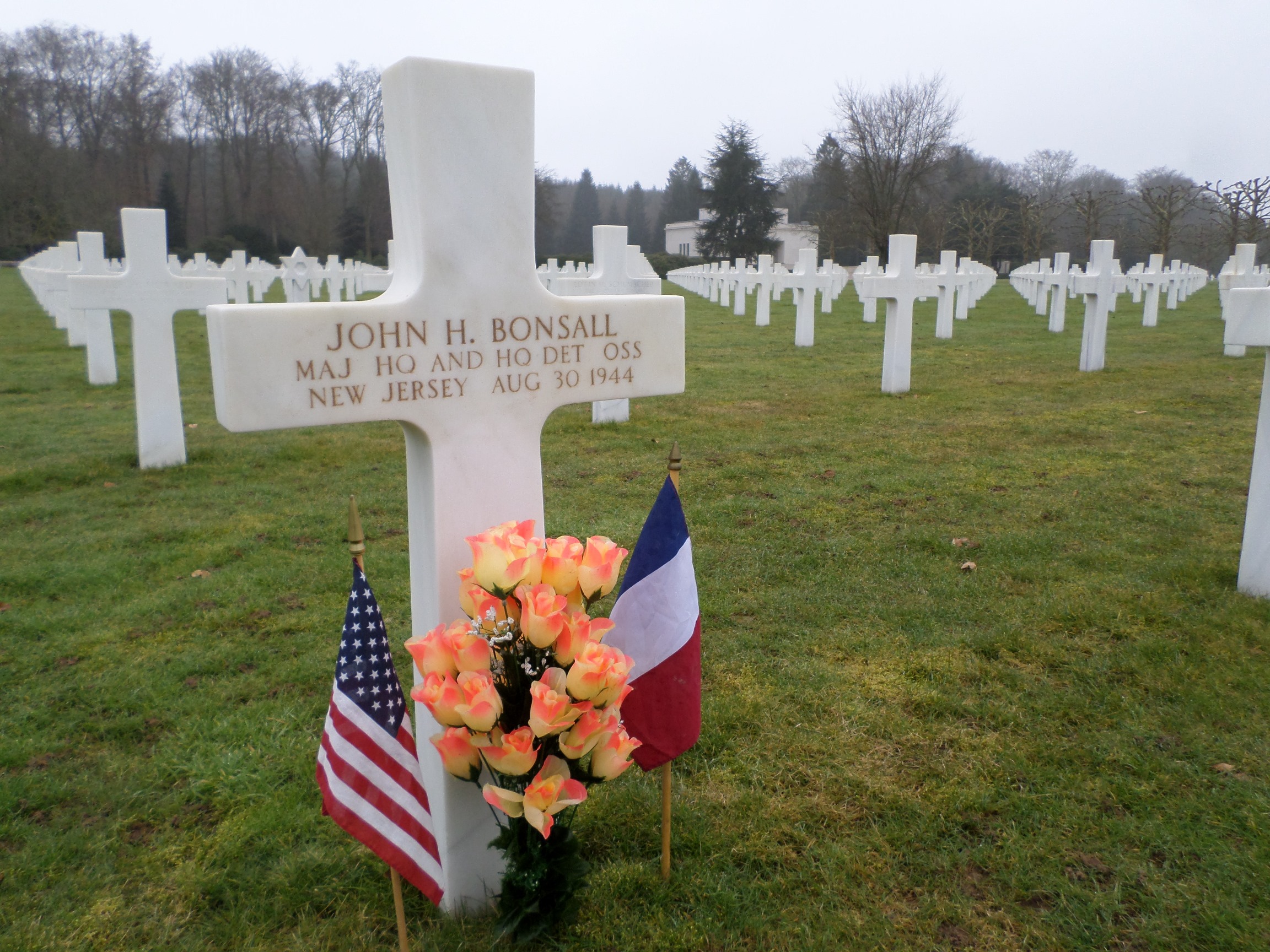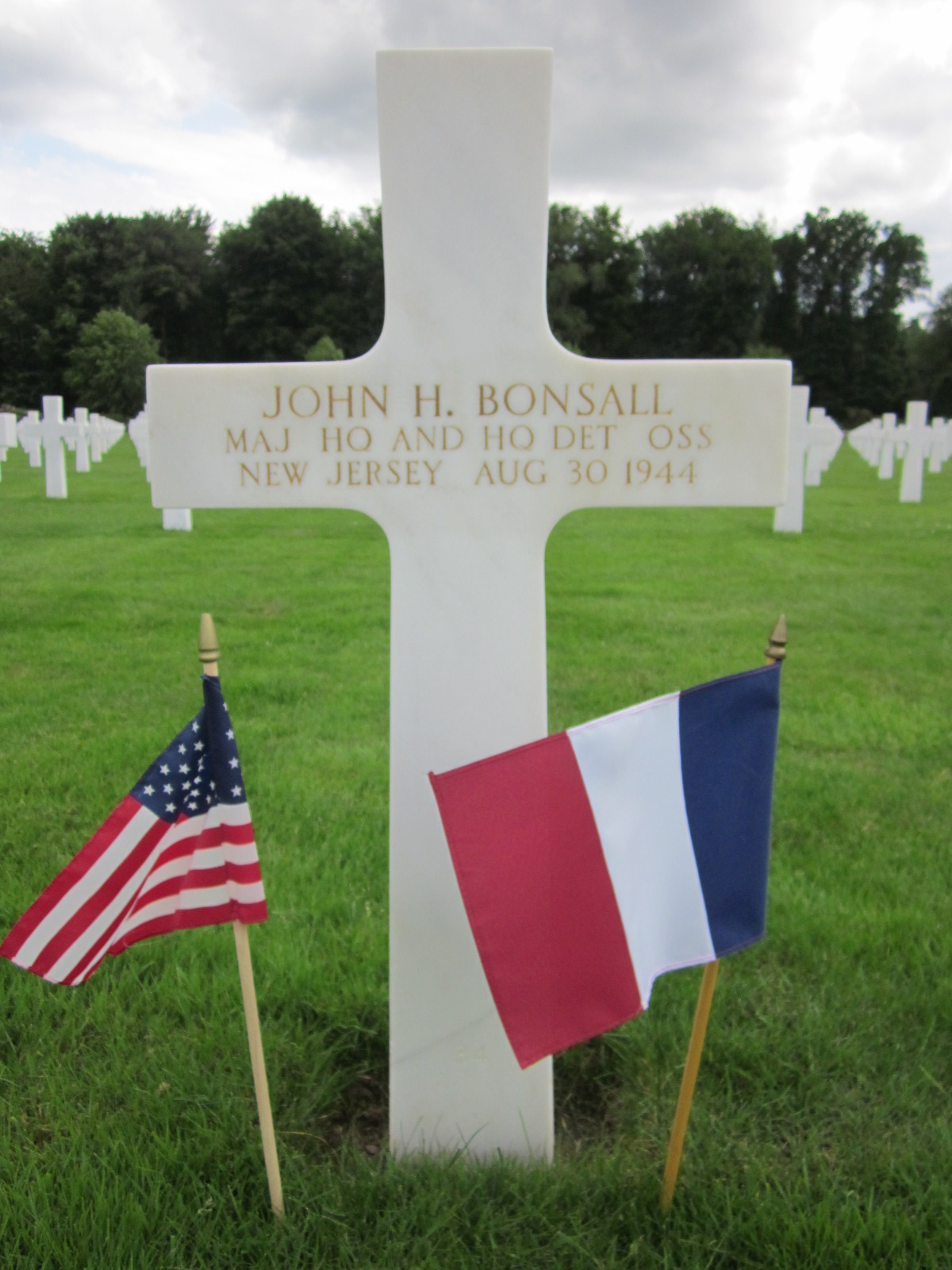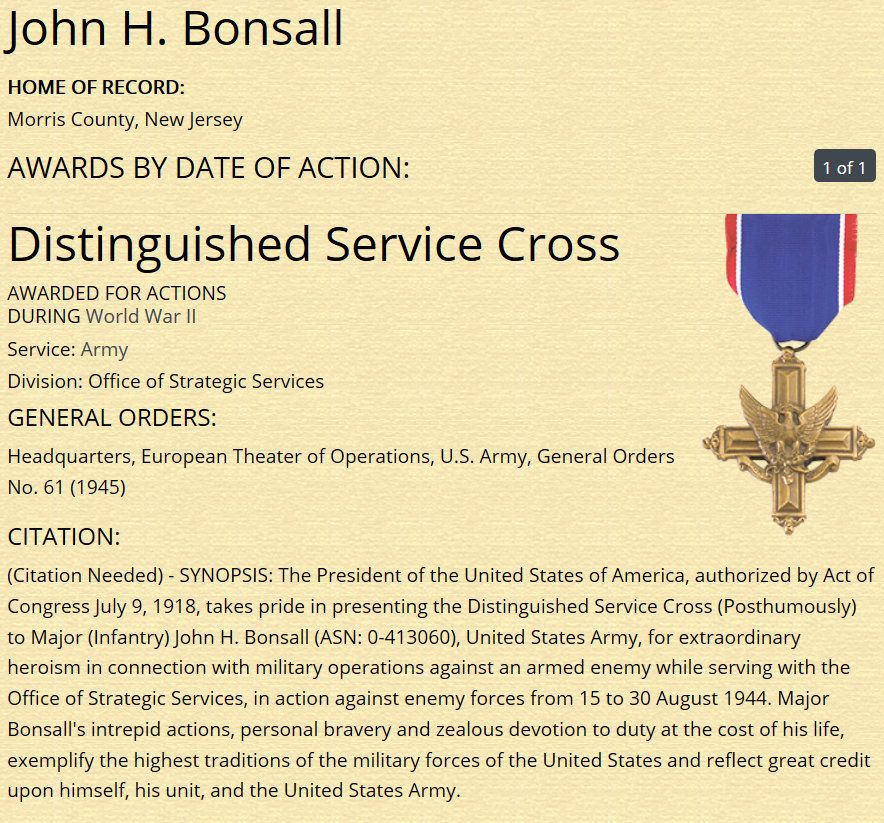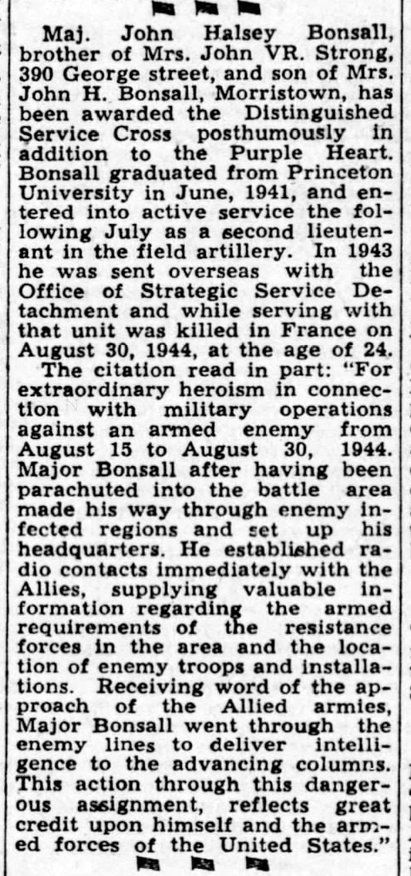He resided in Morris County, New Jersey prior to the war.
John was one of three soldiers "Executed" by the German Army in France during the war.
( see below story )
He was awarded the "Distinguished Service Cross", Purple Heart, and the Prisoner Of War Medal.
Service # O-413060
Son of Mrs. Kathrine N. Bonsall.
John also has a "cenotaph" in the First Presbyterian Church Cemetery, Rockaway, New Jersey.
" Click Here " for that record.
( Bio by: Russ Pickett )
~ ~ ~ ~ ~ ~
The three executed:
Bonsall, John Halsey ~ Major, NJ
Cote, Roger E ~ 1st Sgt, NH
Delviche, Jean ~ Captain, French Army
( Listing & Links by: Russ Pickett )
~ ~ ~ ~ ~ ~
Below Citation Synopsis submitted by:
Dwight "Andy" Anderson
Distinguished Service Cross(Citation Needed) - SYNOPSIS: Major (Infantry) John H. Bonsall (ASN: 0-413060), United States Army, was awarded the Distinguished Service Cross (Posthumously) for extraordinary heroism in connection with military operations against an armed enemy while serving with the Office of Strategic Services, in action against enemy forces from 15 to 30 August 1944. Major Bonsall's intrepid actions, personal bravery and zealous devotion to duty at the cost of his life, exemplify the highest traditions of the military forces of the United States and reflect great credit upon himself, his unit, and the United States Army.
General Orders: Headquarters, European Theater of Operations, U.S. Army, General Orders No. 61 (1945)
Action Date: August 15 - 30, 1944
Service: Army
Rank: Major
Division: Office of Strategic Services
~ ~ ~ ~ ~ ~
Team Augustus, 15 August 1944
SFHQ dispatched Augustus as the thirty-fourth Jedburgh team to the Continent on 15 August 1944 to the Aisne region, where it was to assist the local Maquis and serve as an additional communication link to London.
Major John H. Bonsall, U.S. Army (USA), the team leader, was born on 11 June 1919 in Morristown, New Jersey. After attending a number of preparatory schools, he entered Princeton University, where he was in the ROTC program. He was commissioned an Army second lieutenant upon graduation in 1941, although he planned to follow his father's example and practice law. He was called to active duty in August 1941, arrived in England in December 1943, and was promoted to major in April 1944. Captain Jean Delwiche (French) and Technical Sergeant Roger E. Cote (USA) were the other members of the team. Delwiche was a professional officer born in Vivaise, a small village ten kilometers north of Laon. He was a profoundly quiet man, undoubtedly the result of the death of his wife and child to illness.
On the night of 15 August, the team flew from England with twenty-four containers weighing three tons and with no other passengers. Landing near the hamlet of Colonfay, about fifteen kilometers south of Guise, they moved to Le Nouvion-en-Thierache, the local resistance headquarters. On the afternoon of 16 August, they reached a farm near the village of Clary, which the resistance suggested would be much safer. The team radioed SFHQ on 17 August that the reception had gone perfectly. Two days later, they reported that they had successfully contacted the local resistance leader. At that meeting, they apparently decided to follow the suggestion of the resistance to conduct operations to the south near Soissons. On 20 August, the team radioed that the resistance movement in the Aisne Department was quite advanced, with 1,100 men armed and trained and 4,900 unarmed men.41
On 21 August, the team moved south about 100 kilometers to the village of Rugny. Through 24 August, the team sent London several reports on specific targets for the Allied air forces, mostly large German troop columns headed east for the German border or trains stuck between railroad demolitions. On the 25th, however, Augustus reported that there were so many German troops in the area that it would be unwise to form any Maquis and that hiding places were becoming harder to find. The following day, the team reported that the Germans were constructing field fortifications behind the Aisne River, although without minefields.
On 28 August, they learned that American tanks were in the vicinity and moved north to Soissons. There, they briefed staff officers of the U.S. 3d Armored Division on German defenses in the area. The American officers displayed particular interest in the German camp at Margival.42 SFHQ, on 30 August, sent Augustus the following message:
Have received order from Army commander for FFI to take all possible steps to preserve following Somme bridges from enemy demolition. All bridges Amiens area, also at Moreuil, Boves, Fiquigny, Conde, Longpre. You should attempt to preserve these bridges for about four days after receipt this message. This is important task. Count on you for fullest cooperation. If you need arms can drop from low flying typhoons.43
Team Augustus presumably received this message. That same day, the team passed through the American lines north of Laon (south of Froidmont), an area well known to Captain Delwiche. A subsequent OSS investigation revealed that all three members were shot and killed on the night of 30 August at the village of Barenton-sur-Serre. Apparently, German troops stopped a horse-drawn cart and found the three occupants in civilian clothes, carrying false French identity cards, and equipped with weapons, a radio, and other equipment. Since the German troops were the remnants of an armored unit interested mainly in escaping to the German border, they undertook no further searches but merely shot the team and soon departed in the rain. The horse, still towing its cart, returned on its own to its stable in Mr. Magnien's barn, which was occupied by armed FFI volunteers. The return of the horse and empty cart created considerable consternation. Mr. Magnien and his colleagues found the bodies of Jedburgh I team Augustus the following morning, buried the three men at the Bareriton-sur-Serre cemetery, and subsequently erected a memorial in their honor.44
In total there were 101 Jedburgh Teams, and an equal number of operations were carried out in Europe during their brief history. Most teams were designed for deployment in France, and so France was liberated the scope for future missions was substantially reduced.
~~~~~~~~~~~~~~~~~~~~~~~~~~~~~~~
He resided in Morris County, New Jersey prior to the war.
John was one of three soldiers "Executed" by the German Army in France during the war.
( see below story )
He was awarded the "Distinguished Service Cross", Purple Heart, and the Prisoner Of War Medal.
Service # O-413060
Son of Mrs. Kathrine N. Bonsall.
John also has a "cenotaph" in the First Presbyterian Church Cemetery, Rockaway, New Jersey.
" Click Here " for that record.
( Bio by: Russ Pickett )
~ ~ ~ ~ ~ ~
The three executed:
Bonsall, John Halsey ~ Major, NJ
Cote, Roger E ~ 1st Sgt, NH
Delviche, Jean ~ Captain, French Army
( Listing & Links by: Russ Pickett )
~ ~ ~ ~ ~ ~
Below Citation Synopsis submitted by:
Dwight "Andy" Anderson
Distinguished Service Cross(Citation Needed) - SYNOPSIS: Major (Infantry) John H. Bonsall (ASN: 0-413060), United States Army, was awarded the Distinguished Service Cross (Posthumously) for extraordinary heroism in connection with military operations against an armed enemy while serving with the Office of Strategic Services, in action against enemy forces from 15 to 30 August 1944. Major Bonsall's intrepid actions, personal bravery and zealous devotion to duty at the cost of his life, exemplify the highest traditions of the military forces of the United States and reflect great credit upon himself, his unit, and the United States Army.
General Orders: Headquarters, European Theater of Operations, U.S. Army, General Orders No. 61 (1945)
Action Date: August 15 - 30, 1944
Service: Army
Rank: Major
Division: Office of Strategic Services
~ ~ ~ ~ ~ ~
Team Augustus, 15 August 1944
SFHQ dispatched Augustus as the thirty-fourth Jedburgh team to the Continent on 15 August 1944 to the Aisne region, where it was to assist the local Maquis and serve as an additional communication link to London.
Major John H. Bonsall, U.S. Army (USA), the team leader, was born on 11 June 1919 in Morristown, New Jersey. After attending a number of preparatory schools, he entered Princeton University, where he was in the ROTC program. He was commissioned an Army second lieutenant upon graduation in 1941, although he planned to follow his father's example and practice law. He was called to active duty in August 1941, arrived in England in December 1943, and was promoted to major in April 1944. Captain Jean Delwiche (French) and Technical Sergeant Roger E. Cote (USA) were the other members of the team. Delwiche was a professional officer born in Vivaise, a small village ten kilometers north of Laon. He was a profoundly quiet man, undoubtedly the result of the death of his wife and child to illness.
On the night of 15 August, the team flew from England with twenty-four containers weighing three tons and with no other passengers. Landing near the hamlet of Colonfay, about fifteen kilometers south of Guise, they moved to Le Nouvion-en-Thierache, the local resistance headquarters. On the afternoon of 16 August, they reached a farm near the village of Clary, which the resistance suggested would be much safer. The team radioed SFHQ on 17 August that the reception had gone perfectly. Two days later, they reported that they had successfully contacted the local resistance leader. At that meeting, they apparently decided to follow the suggestion of the resistance to conduct operations to the south near Soissons. On 20 August, the team radioed that the resistance movement in the Aisne Department was quite advanced, with 1,100 men armed and trained and 4,900 unarmed men.41
On 21 August, the team moved south about 100 kilometers to the village of Rugny. Through 24 August, the team sent London several reports on specific targets for the Allied air forces, mostly large German troop columns headed east for the German border or trains stuck between railroad demolitions. On the 25th, however, Augustus reported that there were so many German troops in the area that it would be unwise to form any Maquis and that hiding places were becoming harder to find. The following day, the team reported that the Germans were constructing field fortifications behind the Aisne River, although without minefields.
On 28 August, they learned that American tanks were in the vicinity and moved north to Soissons. There, they briefed staff officers of the U.S. 3d Armored Division on German defenses in the area. The American officers displayed particular interest in the German camp at Margival.42 SFHQ, on 30 August, sent Augustus the following message:
Have received order from Army commander for FFI to take all possible steps to preserve following Somme bridges from enemy demolition. All bridges Amiens area, also at Moreuil, Boves, Fiquigny, Conde, Longpre. You should attempt to preserve these bridges for about four days after receipt this message. This is important task. Count on you for fullest cooperation. If you need arms can drop from low flying typhoons.43
Team Augustus presumably received this message. That same day, the team passed through the American lines north of Laon (south of Froidmont), an area well known to Captain Delwiche. A subsequent OSS investigation revealed that all three members were shot and killed on the night of 30 August at the village of Barenton-sur-Serre. Apparently, German troops stopped a horse-drawn cart and found the three occupants in civilian clothes, carrying false French identity cards, and equipped with weapons, a radio, and other equipment. Since the German troops were the remnants of an armored unit interested mainly in escaping to the German border, they undertook no further searches but merely shot the team and soon departed in the rain. The horse, still towing its cart, returned on its own to its stable in Mr. Magnien's barn, which was occupied by armed FFI volunteers. The return of the horse and empty cart created considerable consternation. Mr. Magnien and his colleagues found the bodies of Jedburgh I team Augustus the following morning, buried the three men at the Bareriton-sur-Serre cemetery, and subsequently erected a memorial in their honor.44
In total there were 101 Jedburgh Teams, and an equal number of operations were carried out in Europe during their brief history. Most teams were designed for deployment in France, and so France was liberated the scope for future missions was substantially reduced.
~~~~~~~~~~~~~~~~~~~~~~~~~~~~~~~
Family Members
Sponsored by Ancestry
Advertisement
Advertisement





